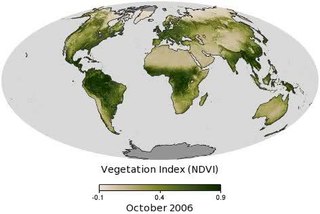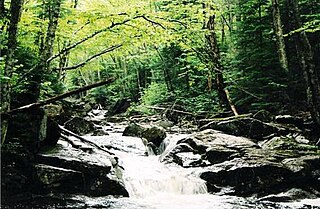Related Research Articles

A biome is a biogeographical unit consisting of a biological community that has formed in response to the physical environment in which they are found and a shared regional climate. Biomes may span more than one continent. Biome is a broader term than habitat and can comprise a variety of habitats.

Ecology is the study of the relationships between living organisms, including humans, and their physical environment. Ecology considers organisms at the individual, population, community, ecosystem, and biosphere level. Ecology overlaps with the closely related sciences of biogeography, evolutionary biology, genetics, ethology, and natural history. Ecology is a branch of biology, and it is not synonymous with environmentalism.

An ecosystem consists of all the organisms and the physical environment with which they interact. These biotic and abiotic components are linked together through nutrient cycles and energy flows. Energy enters the system through photosynthesis and is incorporated into plant tissue. By feeding on plants and on one another, animals play an important role in the movement of matter and energy through the system. They also influence the quantity of plant and microbial biomass present. By breaking down dead organic matter, decomposers release carbon back to the atmosphere and facilitate nutrient cycling by converting nutrients stored in dead biomass back to a form that can be readily used by plants and microbes.

An ecoregion or ecozone is an ecologically and geographically defined area that is smaller than a bioregion, which in turn is smaller than a biogeographic realm. Ecoregions cover relatively large areas of land or water, and contain characteristic, geographically distinct assemblages of natural communities and species. The biodiversity of flora, fauna and ecosystems that characterise an ecoregion tends to be distinct from that of other ecoregions. In theory, biodiversity or conservation ecoregions are relatively large areas of land or water where the probability of encountering different species and communities at any given point remains relatively constant, within an acceptable range of variation.

In ecology, a niche is the match of a species to a specific environmental condition. It describes how an organism or population responds to the distribution of resources and competitors and how it in turn alters those same factors. "The type and number of variables comprising the dimensions of an environmental niche vary from one species to another [and] the relative importance of particular environmental variables for a species may vary according to the geographic and biotic contexts".
Ecological classification or ecological typology is the classification of land or water into geographical units that represent variation in one or more ecological features. Traditional approaches focus on geology, topography, biogeography, soils, vegetation, climate conditions, living species, habitats, water resources, and sometimes also anthropic factors. Most approaches pursue the cartographical delineation or regionalisation of distinct areas for mapping and planning.

A biocenosis, coined by Karl Möbius in 1877, describes the interacting organisms living together in a habitat (biotope). The use of this term has declined in the 21st сentury.

Vegetation is an assemblage of plant species and the ground cover they provide. It is a general term, without specific reference to particular taxa, life forms, structure, spatial extent, or any other specific botanical or geographic characteristics. It is broader than the term flora which refers to species composition. Perhaps the closest synonym is plant community, but vegetation can, and often does, refer to a wider range of spatial scales than that term does, including scales as large as the global. Primeval redwood forests, coastal mangrove stands, sphagnum bogs, desert soil crusts, roadside weed patches, wheat fields, cultivated gardens and lawns; all are encompassed by the term vegetation.

Landscape ecology is the science of studying and improving relationships between ecological processes in the environment and particular ecosystems. This is done within a variety of landscape scales, development spatial patterns, and organizational levels of research and policy. Concisely, landscape ecology can be described as the science of "landscape diversity" as the synergetic result of biodiversity and geodiversity.
This glossary of ecology is a list of definitions of terms and concepts in ecology and related fields. For more specific definitions from other glossaries related to ecology, see Glossary of biology, Glossary of evolutionary biology, and Glossary of environmental science.

Ecosystem ecology is the integrated study of living (biotic) and non-living (abiotic) components of ecosystems and their interactions within an ecosystem framework. This science examines how ecosystems work and relates this to their components such as chemicals, bedrock, soil, plants, and animals.
Phytosociology, also known as phytocoenology or simply plant sociology, is the study of groups of species of plant that are usually found together. Phytosociology aims to empirically describe the vegetative environment of a given territory. A specific community of plants is considered a social unit, the product of definite conditions, present and past, and can exist only when such conditions are met. In phyto-sociology, such a unit is known as a phytocoenosis. A phytocoenosis is more commonly known as a plant community, and consists of the sum of all plants in a given area. It is a subset of a biocoenosis, which consists of all organisms in a given area. More strictly speaking, a phytocoenosis is a set of plants in area that are interacting with each other through competition or other ecological processes. Coenoses are not equivalent to ecosystems, which consist of organisms and the physical environment that they interact with. A phytocoensis has a distribution which can be mapped. Phytosociology has a system for describing and classifying these phytocoenoses in a hierarchy, known as syntaxonomy, and this system has a nomenclature. The science is most advanced in Europe, Africa and Asia.
In landscape ecology, landscape connectivity is, broadly, "the degree to which the landscape facilitates or impedes movement among resource patches". Alternatively, connectivity may be a continuous property of the landscape and independent of patches and paths. Connectivity includes both structural connectivity and functional connectivity. Functional connectivity includes actual connectivity and potential connectivity in which movement paths are estimated using the life-history data.
The following outline is provided as an overview of and topical guide to ecology:

A geotope is the geological component of the abiotic matrix present in an ecotope. Example geotopes might be an exposed outcrop of rocks, an erratic boulder, a grotto or ravine, a cave, an old stone wall marking a property boundary, and so forth.

Canada has 20 major ecosystems -- ecozones, comprising 15 terrestrial units and 5 marine units. These ecozones are further subdivided into 53 ecoprovinces, 194 ecoregions, and 1,027 ecodistricts. These form the country's ecological land classification within the Ecological Land Classification framework adopted in 2017. They represent areas of the earth's surface representative of large and very generalized ecological units characterized by interactive and adjusting biotic and abiotic factors.

The classification of natural regions of Saxony shown here was produced between 1994 and 2001 by a working group called "Ecosystem and Regional Character" at the Saxonian Academy of Sciences in Leipzig as part of the research and development project "Natural Regions and Natural Region Potential of the Free State of Saxony" at a scale of 1:50,000 as the basis for the rural development and regional planning. This was also supported by the Saxon State Ministry of the Environment and Agriculture and the Saxon Ministry of the Interior.

Ecosystem Functional Type (EFT) is an ecological concept to characterize ecosystem functioning. Ecosystem Functional Types are defined as groups of ecosystems or patches of the land surface that share similar dynamics of matter and energy exchanges between the biota and the physical environment. The EFT concept is analogous to the Plant Functional Types (PFTs) concept, but defined at a higher level of the biological organization. As plant species can be grouped according to common functional characteristics, ecosystems can be grouped according to their common functional behavior.
Seascape ecology is a scientific discipline that deals with the causes and ecological consequences of spatial pattern in the marine environment, drawing heavily on conceptual and analytical frameworks developed in terrestrial landscape ecology.
Ecological units, comprise concepts such as population, community, and ecosystem as the basic units, which are at the basis of ecological theory and research, as well as a focus point of many conservation strategies. The concept of ecological units continues to suffer from inconsistencies and confusion over its terminology. Analyses of the existing concepts used in describing ecological units have determined that they differ in respects to four major criteria:
- The questions as to whether they are defined statistically or via a network of interactions,
- If their boundaries are drawn by topographical or process-related criteria,
- How high the required internal relationships are,
- And if they are perceived as "real" entities or abstractions by an observer.
References
- ↑ Sørensen, T. (1936). "Some ecosystemtical characteristics determined by Raunkiær's circling method". Nordiska (19. skandinaviska) naturforskarmötet i Helsingfors den 11-15 augusti 1936 : 474–475. "To designate the fundamental unit of ecological plant sociology I propose the term ecotope, viz. the field delimited as an object of investigation within a given ecosystem (Tansley)"